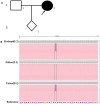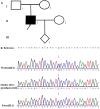The Evaluation of Genetic Diagnosis on High-Risk Fetal CAKUT
- PMID: 35711925
- PMCID: PMC9194390
- DOI: 10.3389/fgene.2022.869525
The Evaluation of Genetic Diagnosis on High-Risk Fetal CAKUT
Abstract
Background: It is challenging to make an accurate prenatal diagnosis for congenital anomalies of the kidney and urinary tract (CAKUT) because of its pathologic diversity. This study aims to evaluate the performance of whole-exome sequencing (WES) combined with karyotype analysis and copy number variations (CNVs) in diagnosing high-risk fetal CAKUT. Methods: We conducted a retrospective study on prenatal diagnoses of CAKUT in our hospital from January 2020 to April 2021. The research studied 24 high-risk fetuses with CAKUT who were scanned by ultrasonography at the prenatal diagnosis center of Tongji Hospital affiliated to Tongji Medical College of Huazhong University of Science and Technology. The likely pathogenic gene variants were screened for the patients and their parents by multiple approaches, including karyotype analysis, CNVs and WES, and further verified with Sanger sequencing. Results: ①We detected abnormal CNVs in 20.8% (5/24) of the fetuses but only 8.3% (2/24) fetuses had abnormal karyotypes. ②Of the 15 CAKUT fetuses, positive findings (40%) were detected by WES. Of the 9 high-risk fetuses with CAKUT (negative findings in ultrasound scan but with family history), we found abnormal variants (77.8%) through WES. Conclusion: The application of CNVs and WES showed advance in prenatal diagnosis of CAKUT and the pathogenic gene variants were detectable especially for high-risk fetuses with negative ultrasound findings on CAKUT in the preliminary study. The applied strategy could be used to improve the accuracy of prenatal diagnosis for CAKUT in the future.
Keywords: (copy number variants); CAKUT; karyotype analysis; prenatal diagnosis; whole-exome sequencing.
Copyright © 2022 Liu, Shi, Li, Qiao, Chen, Feng, Zeng, Deng and Wu.
Conflict of interest statement
The authors declare that the research was conducted in the absence of any commercial or financial relationships that could be construed as a potential conflict of interest.
Figures




Similar articles
-
Spectrum of congenital anomalies of the kidney and urinary tract (CAKUT) including renal parenchymal malformations during fetal life and the implementation of prenatal exome sequencing (WES).Arch Gynecol Obstet. 2024 Jun;309(6):2613-2622. doi: 10.1007/s00404-023-07165-8. Epub 2023 Aug 3. Arch Gynecol Obstet. 2024. PMID: 37535131 Free PMC article.
-
Copy Number Variation Analysis Facilitates Identification of Genetic Causation in Patients with Congenital Anomalies of the Kidney and Urinary Tract.Eur Urol Open Sci. 2022 Sep 1;44:106-112. doi: 10.1016/j.euros.2022.08.004. eCollection 2022 Oct. Eur Urol Open Sci. 2022. PMID: 36185583 Free PMC article.
-
Whole-exome sequencing for prenatal diagnosis of fetuses with congenital anomalies of the kidney and urinary tract.Nephrol Dial Transplant. 2017 Oct 1;32(10):1665-1675. doi: 10.1093/ndt/gfx031. Nephrol Dial Transplant. 2017. PMID: 28387813
-
Prenatal genetic considerations of congenital anomalies of the kidney and urinary tract (CAKUT).Prenat Diagn. 2019 Aug;39(9):679-692. doi: 10.1002/pd.5536. Epub 2019 Aug 5. Prenat Diagn. 2019. PMID: 31343747 Free PMC article. Review.
-
Prenatal diagnosis and outcome of fetal hyperechogenic kidneys in the era of antenatal next-generationsequencing.Clin Chim Acta. 2022 Mar 1;528:16-28. doi: 10.1016/j.cca.2022.01.012. Epub 2022 Jan 20. Clin Chim Acta. 2022. PMID: 35065907
Cited by
-
Identification and functional interpretation of miRNAs affected by rare CNVs in CAKUT.Sci Rep. 2022 Oct 22;12(1):17746. doi: 10.1038/s41598-022-22749-1. Sci Rep. 2022. PMID: 36273030 Free PMC article.
-
Genetic testing and diagnostic strategies of fetal skeletal dysplasia: a preliminary study in Wuhan, China.Orphanet J Rare Dis. 2023 Oct 25;18(1):336. doi: 10.1186/s13023-023-02955-4. Orphanet J Rare Dis. 2023. PMID: 37875969 Free PMC article.
-
Genetic Spectrum of Congenital Anomalies of the Kidney and Urinary Tract in Chinese Newborn Genome Project.Kidney Int Rep. 2023 Aug 14;8(11):2376-2384. doi: 10.1016/j.ekir.2023.08.005. eCollection 2023 Nov. Kidney Int Rep. 2023. PMID: 38025242 Free PMC article.
-
Global, regional, and national burden of congenital anomalies of the kidney and urinary tract from 1990 to 2021, with projections to 2036: a systematic analysis of the global burden of disease study 2021.BMC Nephrol. 2025 Jul 1;26(1):334. doi: 10.1186/s12882-025-04269-y. BMC Nephrol. 2025. PMID: 40597805 Free PMC article.
References
LinkOut - more resources
Full Text Sources
Miscellaneous

